
Pleurothallis is a genus of orchids commonly called bonnet orchids. The genus name is derived from the Greek word pleurothallos, meaning "riblike branches". This refers to the rib-like stems of many species. The genus is often abbreviated as "Pths" in horticultural trade.
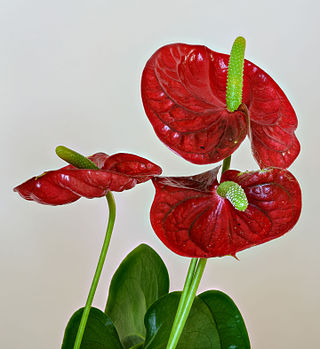
Anthurium is a genus of about 1,000 species of flowering plants, the largest genus of the arum family, Araceae. General common names include anthurium, tailflower, flamingo flower, pigtail plant, and laceleaf.
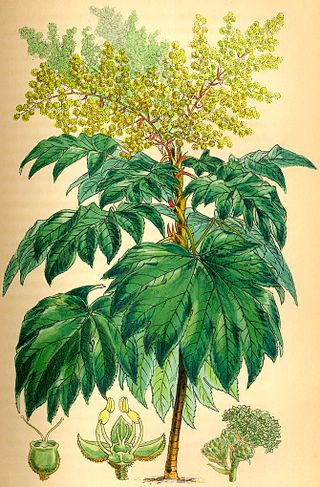
Tetrapanax papyrifer, the rice paper plant, is an evergreen shrub or small tree in the family Araliaceae, the sole species in the genus Tetrapanax. The specific epithet is frequently misspelled as "papyriferum", "papyriferus", or "papyrifera". It is native to eastern and central China and Taiwan, but widely cultivated in East Asia and in other tropical to mild temperate regions as well.
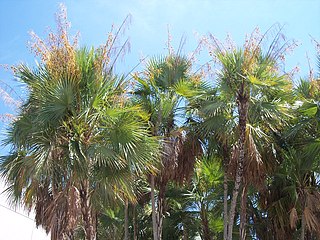
Acoelorraphe is a genus of palms with a single species Acoelorraphe wrightii, known as the Paurotis palm, Everglades palm or Madeira palm in English and cubas, tique, and papta in Spanish. The genus name is sometimes spelt as Acoelorrhaphe or Acoelorhaphe, which are treated by orthographical variants by the International Plant Names Index.

Ipomoea cairica is a vining, herbaceous, perennial plant with palmate leaves and large, showy white to lavender flowers. A species of morning glory, it has many common names, including mile-a-minute vine, Messina creeper, Cairo morning glory, coast morning glory and railroad creeper. The species name cairica translates to "from Cairo", the city where this species was first collected.
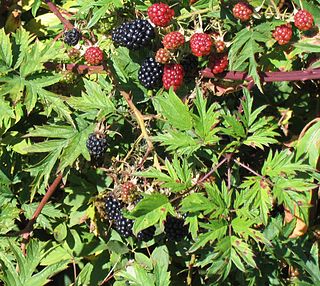
Rubus laciniatus, the cutleaf evergreen blackberry or evergreen blackberry, is a species of Rubus, native to Eurasia. It is an introduced species in Australia and North America. It has become a weed and invasive species in forested habitats in the United States and Canada, particularly in the Northeast and along the Pacific Coast.

Chloropyron palmatum is an endangered species of salt-tolerant, flowering plant in the family Orobanchaceae. It is a low, highly branched herbaceous annual with each flower enclosed by a single, characteristically palmate bract. It is known by the common names of palmate salty bird's-beak and palmate-bract bird's-beak.

Anthurium pedatoradiatum or Anthurium Fingers is a species of plant in the genus Anthurium native to southern Mexico. A. pedatoradiatum has leaves with deep finger-like sections, and is terrestrial. Its natural habitat is from sea level up to 1,000 meters (3,300 ft) in the Mexican states of Veracruz, Tabasco, and Chiapas. It is related to other Anthurium in the section Schizoplacium such as Anthurium podophyllum, and its species name in Latin refers to the radiating growth of its palm-like leaves.
Thomas Bernard Croat is an American botanist and plant collector, noteworthy as one of botanical history's "most prolific plant collectors". He has collected and described numerous species of plants, particularly in the family Araceae, in his career at the Missouri Botanical Garden.
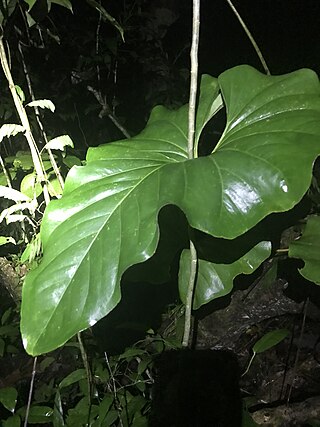
Anthurium brownii is a species of plant in the genus Anthurium native to Central and South America, from Costa Rica through Panamá, and south to Colombia, Ecuador, and Venezuela. First scientifically described in 1876, it was collected by Gustav Wallis and named for N. E. Brown. A. brownii grows from sea level up to 1,200 meters (3,900 ft) in tropical forests.

Anthurium clidemioides is a species of plant in the genus Anthurium native to Costa Rica, Panama, and Colombia. One of the more distinctive Anthuriums, it is a vining climber with almost stalkless, bullate leaves that can range from light to very dark green. Along with Anthurium flexile it is one of only two species in the genus that produces roots between nodes.
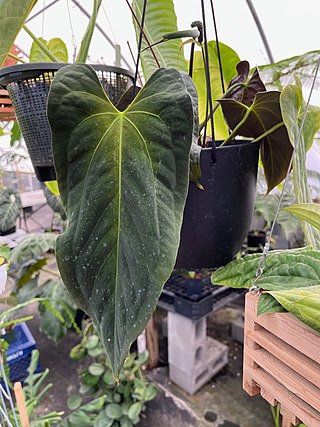
Anthurium papillilaminum is a species of plant in the genus Anthurium native to Panama. A. papillilaminum grows terrestrially and has very dark green cordate leaves on short stems. Its native range is very limited, with the species endemic to only the coasts of Colón Province and Darién Province up to 100 meters (330 ft) above sea level. A member of the section Cardiolonchium, it is closely related to other velvet-leaved Anthuriums, though it does not have silver veins on the leaves like Anthurium crystallinum.
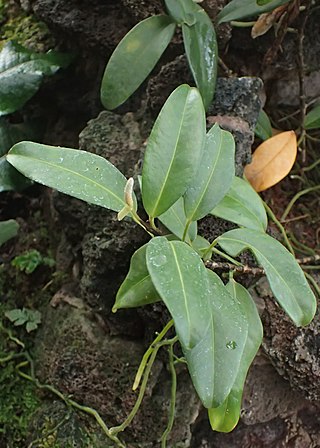
Anthurium scandens is a species of plant in the genus Anthurium. Native from Mexico to Southeast Brazil, it is the most widely distributed species of Anthurium in the Americas, and also extends to the Caribbean including Haiti, Puerto Rico, Jamaica, and other nations.

Anthurium podophyllum is a species of plant in the genus Anthurium native to coastal areas of the Mexican states of Veracruz and Oaxaca. A terrestrial species, it grows in tropical forest understories in seasonally dry areas. It is named for its palmate leaves that somewhat resemble plants in the (unrelated) genus Podophyllum, and which have many subdivisions. It is related to other terrestrial Anthurium with similar leaf morphology in the section Schizoplacium, such as Anthurium pedoradiatum, and produces orange berries.

Anthurium microspadix is a species of plant in the genus Anthurium. Growing as an epiphyte or a terrestrial shrub, it is native from the southern Mexican states of Oaxaca and Chiapas to Bolivia from 800–2,300 metres (2,600–7,500 ft) in elevation. One of the more widely distributed and variable species in its genus, it is easily confused with species such as Anthurium pallens and others.
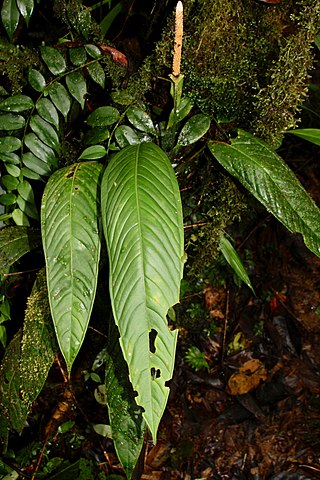
Anthurium pallens is a species of plant in the genus Anthurium. Growing as a climbing epiphyte with short stems and usually pendent growth, it is native to Central America. Easily confused with other species such as Anthurium microspadix, it can be distinguished by its typically shorter branches and leaf blades acute to rounded at the base.

Anthurium formosum is a species of plant in the genus Anthurium native to Central and South America. Epiphytic or terrestrial, it is found from Nicaragua to Colombia and northwest Venezuela.

Anthurium dwyeri is a species of plant in the genus Anthurium native from Costa Rica to the Chocó Department of Colombia. Named in honor of the botanist Dr John D. Dwyer, it has no known close relatives but is a member of the section Porphyrochitonium. An epiphyte, it is most easily recognizable by its leathery, oblong to elliptical leaves that are 24–40 centimetres (9.4–15.7 in) long and grow on triangular stems.

Anthurium wendlingeri is a species of aroid plant, in the genus Anthurium, found from Central to South America, from SE Nicaragua to NW Colombia. It grows in moist, montane tropical habitats as an epiphyte. Unique among its genus, A. wendlingeri has long, pendant and strap-like leaves, and can have a slightly velvety appearance.
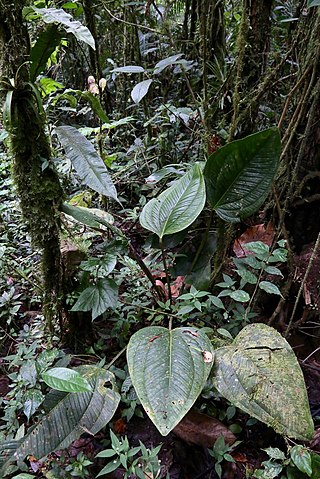
Anthurium ovatifolium is a species of plant in the genus Anthurium native to Colombia, Ecuador, and Peru. It grows in wet tropical habitats, and is a member of the section Digitinervium. Its species name refers to the oval shape of its leaves, and it can be distinguished from similar species like Anthurium lentii by its red berries.



















